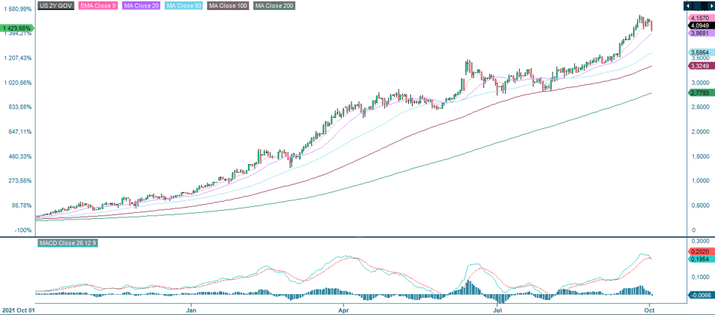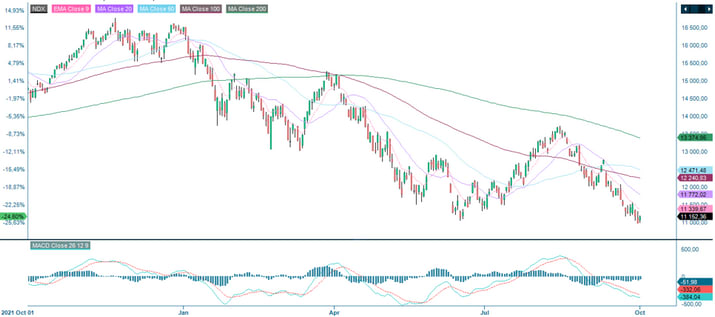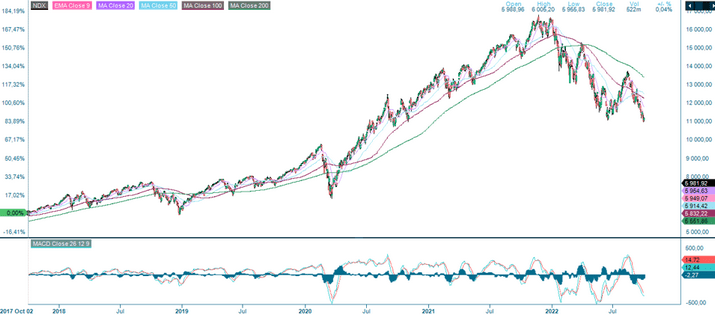Nasdaq may rebound on short-term lower interest rates

Monday’s downward rebound in US Treasury rates could trigger the Nasdaq index, linked to its higher valuation based on more anticipated future profits. Nasdaq is technically also traded around a support level.
Rising bond
yields continue to put pressure on world stock markets. Meanwhile, it is
interesting to note that both the Bank of England and China's central bank have
started to stimulate their economies with, among other things, government bond
buybacks. The decisive moment in the market will be when the Fed changes foot,
but we are not there yet. Rising bond yields and falling risk appetite for
low-rated bonds are also raising concerns about major credit defaults, with
Credit Suisse being the latest.
The world's major
stock market indices have declined by between five and eight per cent in the
past month, with the Japanese Nikkei being the only positive exception.
Significant stock indices performance in one week, one month and this year

However, despite the described long-term sentiment, we may have entered into a short-time rebound phase for the US and European stock markets. The USD/SEK has weakened slightly, and, above all, the US 2-year and 10-year Treasury yields recoiled by 9 and 14 bps on Monday, 3 October. The stock market is starting to price in a recession. In our view, the 2-year US Treasury rate is a better leading indicator of inflation expectations compared to the 10-year rate. Today’s exceptionally high inflation rate is expected to decline sooner or later. We have seen a few signs of lower raw material and transportation costs lately. After all, how should consumers afford all these increasing prices? They must adopt and decrease their spending and consumption accordingly.
US 2 Year Treasury yield (in %), a daily one-year price chart

The USD has also
fallen back slightly, about 3% against the SEK, in the past week. A rising USD
usually means a falling stock market and vice versa.
So how should you
position yourself if you believe in a short-term interest rate cooling?
Sector-wise, it's about property companies rather than banks. But we think the
Nasdaq index could also look heavily oversold. This is where higher Price/Earnings
(P/E)-multiples come into play, as a more significant proportion of technology
companies' profits are expected to materialise further down the line. Lower
interest rates= lower return requirements and higher P/E ratios, all else
equal. This means that the Nasdaq should do better than the Dow Jones in
particular, but also to some extent than the S&P500 index (considering that
the latter contains some 25% of FANG stocks).
Nasdaq Index (in USD), a daily one-year share price chart

Technically, the Nasdaq index has rebounded to 10,740 at the time of writing, some 0.9% higher than the low of 10,646 reached on 16 June. Today's level is thus close to support (albeit it looks very fragile). The closest the Nasdaq was to today’s price levels was in October-November 2020, after a quick rebound from the Covid pandemic bottom in March 2020.
Nasdaq Index (in USD), a weekly five-year share price chart

The full name for abbreviations used in the previous text:
EMA 9: 9-day exponential moving average
Fibonacci: There are several Fibonacci lines used in technical analysis.
Fibonacci numbers are a sequence of numbers in which each successive number is
the sum of the two previous numbers.
MA20: 20-day moving average
MA50: 50-day moving average
MA100: 100-day moving average
MA200: 200-day moving average
MACD: Moving average convergence divergence
Risks
Important notice:
This information is neither an investment advice
nor an investment or investment strategy recommendation, but advertisement. The
complete information on the trading products (securities) mentioned herein, in
particular the structure and risks associated with an investment, are described
in the base prospectus, together with any supplements, as well as the final
terms. The base prospectus and final terms constitute the solely binding sales
documents for the securities and are available under the product links. It is
recommended that potential investors read these documents before making any
investment decision. The documents and the key information document are
published on the website of the issuer, Vontobel Financial Products GmbH,
Bockenheimer Landstrasse 24, 60323 Frankfurt am Main, Germany, on
prospectus.vontobel.com and are available from the issuer free of charge. The
approval of the prospectus should not be understood as an endorsement of the
securities. The securities are products that are not simple and may be
difficult to understand. This information includes or relates to figures
of past performance. Past performance is not a reliable indicator of future results.
